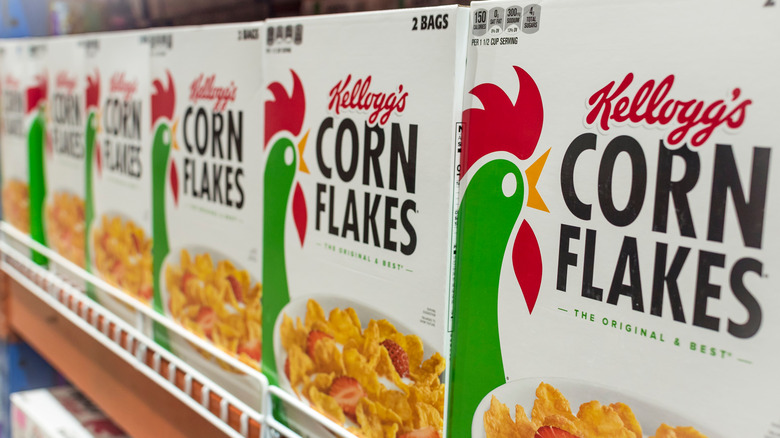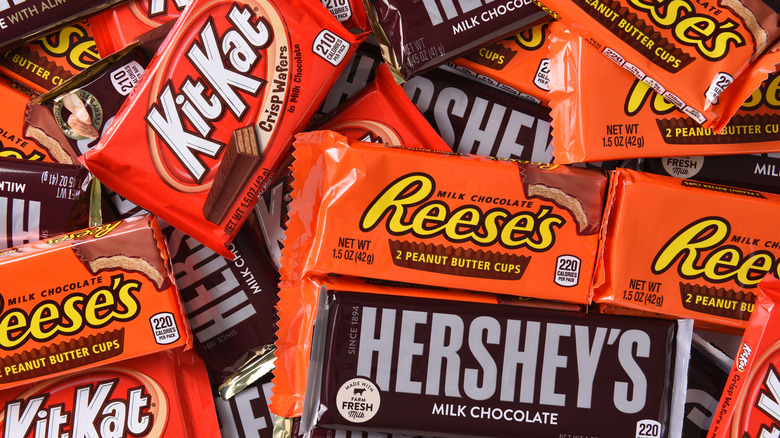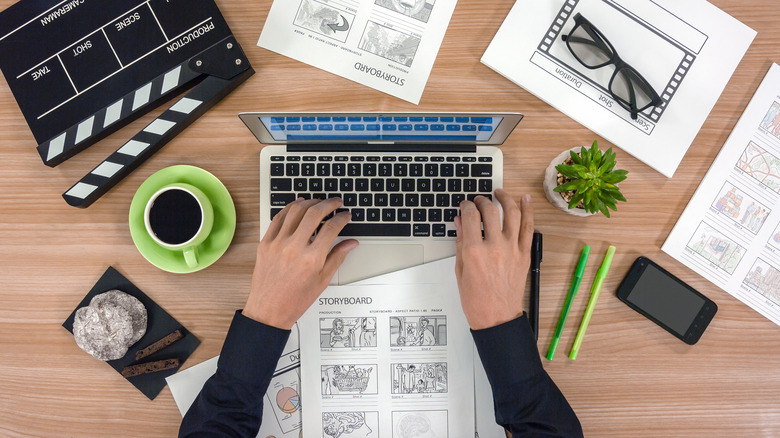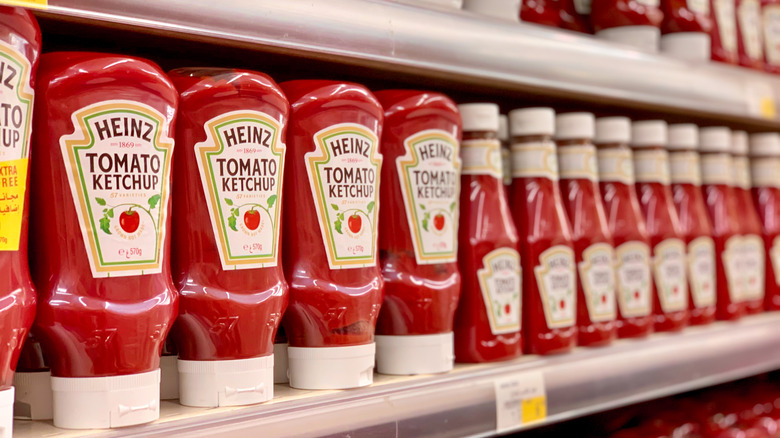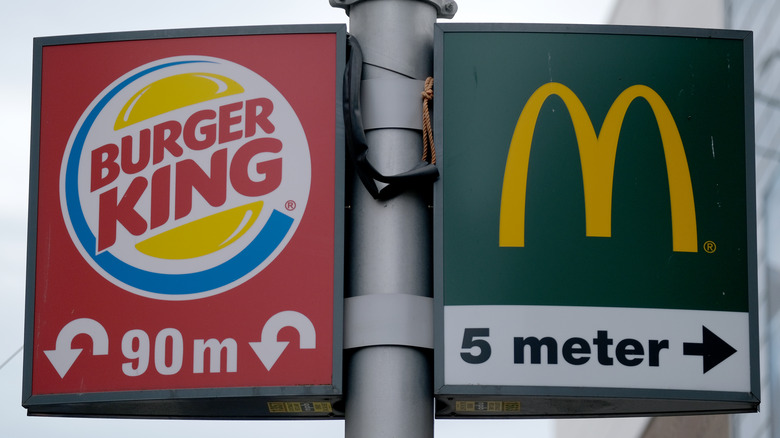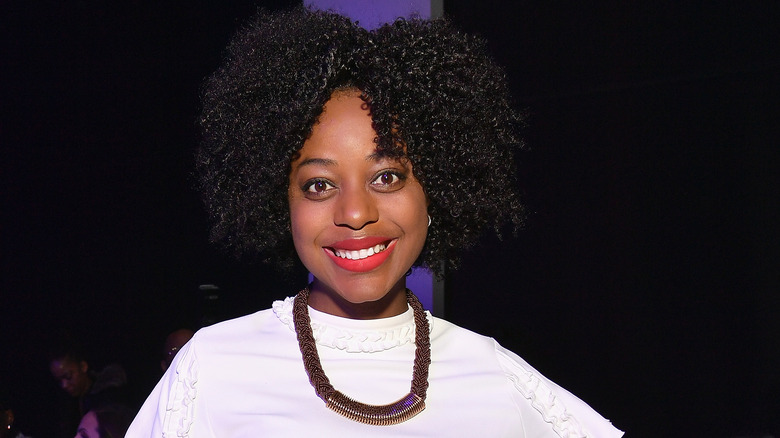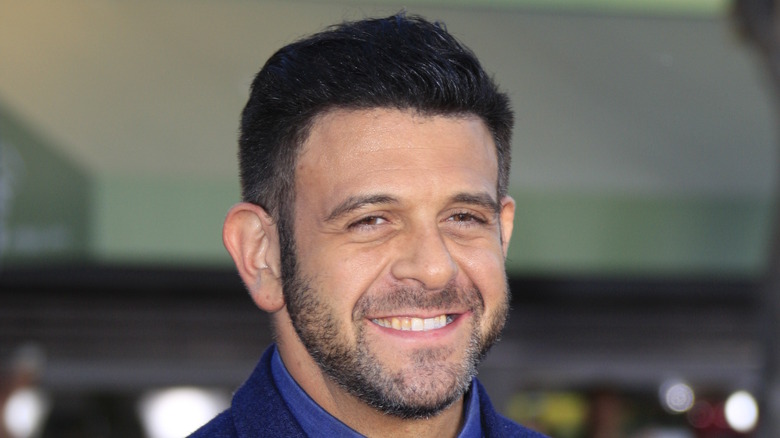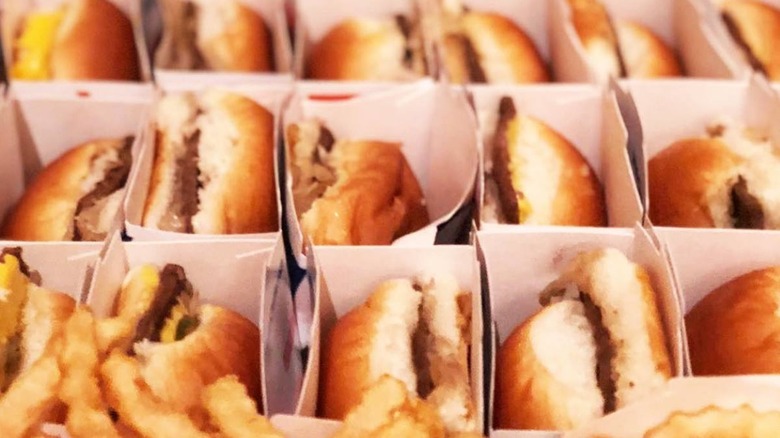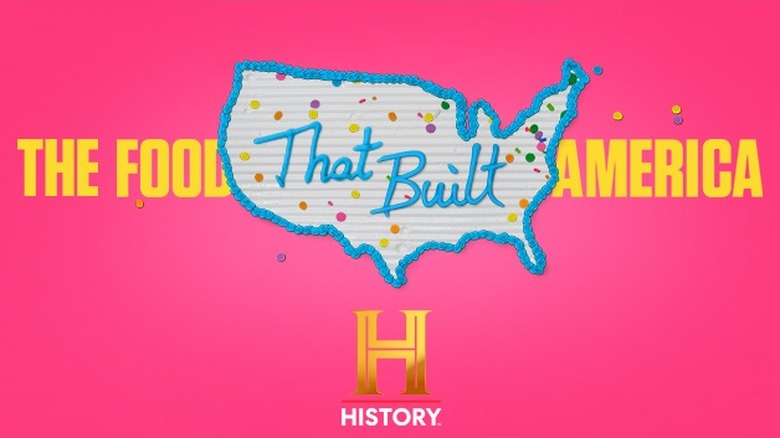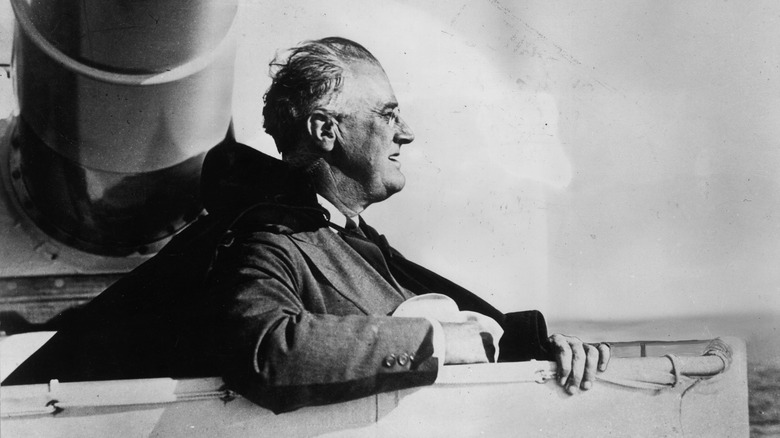The Untold Truth Of The Food That Built America
In early August of 2019, a new kind of show debuted on the History Channel. It told the story of the innovations that began to take place in the post-Civil War United States. But it didn't only recount the story of industrialization and urbanization, but also of the subsequent outcomes.
"The Food That Built America" shines a spotlight on the people behind the big-name brands familiar to most consumers today, such as Henry Heintz, the Kellogg brothers, Charles William Post, and Milton Hershey. Few inventions have smoothly sailed into the hearts of Americans, and the foods we take for granted today have each had their own struggles to get there.
In the popular History Channel series (Season 1 attracted 18.8 million total viewers), these stories are told through dramatic reenactment and interviews with food historians. Award-winning actor Campbell Scott ties it all together into a continuous narrative. But what about the story behind the stories? What goes into making a docudrama? And just how interesting are these alleged innovators anyway? Read on to discover the answers to these questions and more.
The Food That Built America exploits our nostalgia
Every generation feels nostalgia for the years past, and food plays a significant role in these recollections. Maybe it's a special cereal you used to have for breakfast every morning as a kid or perhaps your favorite Halloween candy bar.
"There's this built-in nostalgia for these products," showrunner Yoshi Stone explains in an interview with TheWrap. "There are great stories, but the stories matter to you more because the products are so familiar and most people have some kind of an emotional bond with at least some of them." This familiarity ultimately builds a connection with the viewers.
Stone goes on to explain that what sets "The Food That Built America" apart from other documentary series is that the audience witnesses the countless obstacles and endeavors necessary to the creation of recognizable products. This makes the show not only educational but enjoyable. Even though the audience knows that these brand founders eventually succeed, it's easy to become drawn into their struggles. The emotional tension comes from the fact that the stories speak directly to consumers who regularly take joy in the products developed by the brands.
The writers sometimes skew the facts
Historical reenactment is always a tricky business. No one alive today has personal lived experiences regarding the bulk of human history. Even with the help of diaries and memoirs, it can be difficult to truly put oneself in the shoes of a historical figure. A modern-day mindset will always influence our views of the past.
To make media like television interesting, you need a powerful visual element. Of course, this can be achieved with photographs, but more engaging are the actors who put the "moving" into "moving pictures." Thus we have docudramas in which costumed actors recreate scenes from the past. But how accurate are these recreations and can the writers be trusted?
Showrunner Yoshi Stone admits in an interview with TheWrap that some accounts are backed by loads of information and historical records while others are not. He says, "In those cases, we need to dig harder and go deeper in order to create a version of events that we feel confident in. Because it is on History Channel and it is a documentary and we want to be factually accurate."
In a similar vein, the scenarios acted out are accompanied by swells of music for dramatic emphasis and an exaggerated tone by the narrator. All of these factors have an effect on the viewers' emotions and attitudes, as pointed out by TV Worth Watching.
This is a serious take on food history and culture
While "The Food That Built America" may not have the highest budget, it is sincere in its delivery. For example, journalist Kimberly Roots recounts how seriously two actors regard a french fry in an episode about McDonald's and Burger King (via TVLine). What might appear unimportant on a breezy show is examined in more depth in the episodes which are packed with information.
And while the stories portrayed may seem sensational — even a bit melodramatic, they are factual and often rely on guests who share their deeper knowledge. Food historian Sarah Wassberg Johnson is among the researchers and experts called upon to elaborate on certain topics.
The show also gives context to popular brand names by exposing the people behind them. As regular show contributor and food enthusiast Adam Richman told Mashed, "I think that we hear Heinz, we hear Hershey, we hear Birdseye, we hear Wise ... We think about brands. We don't think they're people." He goes on to say, "I think that it's cool to demystify these brands, it's cool to see the people behind the package."
It showcases American ingenuity
One Redditor in the r/Capitalism community sums up "The Food That Built America" succinctly: "If you want to get a good look at capitalism, entrepreneurs, and business watch the series on the History Channel called 'The Food that Built America.'" Each episode is, indeed, an in-depth look at the ingenuity of food innovators and the rise of American capitalism.
After the Civil War, many people relocated from the countryside to cities, according to History.com. No longer able to grow their own food, they needed someone else to supply it for them. Food preservation had yet to be refined, and a lot of goods headed to cities spoiled before arrival, according to Media Entertainment Arts WorldWide (MEAWW).
It was in this atmosphere that Henry John Heinz developed his now world-renowned ketchup. He also introduced better working conditions, higher pay, and other benefits as a way to incentivize his employees (via Deutsche Welle). Similarly, Milton Hershey provided enviable (at the time) working conditions for his workers when he developed the infrastructure for Hershey, Pennsylvania, which continues to thrive today (via Smithsonian Magazine). Company towns were nothing new for the early 1900s, but such a clean and comfortable place to live in was a bonus for employees. These men and others set the tone for American industry in the 20th century.
Our favorite foods starred as the winners of fierce battles
No, we aren't talking about literal wartime battles, though many of these food entrepreneurs certainly did benefit from wartime, per MEAWW. Instead, we mean the fierce competition that grew out of launching a new product and dealing with copycats.
The first episode of Season 1, "Lines in the Sand," tells the story of the Kellogg brothers, John and Will. The brothers invented Corn Flakes as a health food to cure indigestion as well as what John saw as sinful behavior. The viewers are also led through the betrayal of John's sanitarium patient, C.W. Post. John patented the Kellogg's cereal recipe while Post, on the other hand, created Grape Nuts and marketed them with the claim that they would cure illnesses. With this invention, the great cereal war was on.
What follows in the next episode, "Best Served Cold," is a heated competition between Milton Hershey and Frank Clarence Mars upon the creation of the famous Milky Way chocolate bar (via MEAWW). Mars also encountered rockiness working with his son Forrest, who went on to invent M&Ms. Meanwhile, Season 2 kicks off with "Pizza Wars" (featuring Pizza Hut vs. Domino's), soon followed by "The Kings of Burgers" highlighting the McDonald's and Burger King rivalry.
You won't see the grocery aisle the same way
Probably few of us have wondered about the names behind popular brands like Lay's (Herman Lay), Taco Bell (Glen Bell), or Kraft (James L. Kraft). This is exactly what "The Food That Built America" strives to change, by enlightening the public on the history of the brands we take for granted every day. And once you know about the often drama-filled tales, you will never look at the items on your grocery shelves the same way again. It turns out that's exactly what the show's contributor and food enthusiast Adam Richman wants to achieve, as he shares in an interview with the Vegas Food Critic.
And this endeavor is paying off. One viewer wrote on Twitter, "Walking down the food aisles is so different after watching The Food That Built America." Posting a picture of a bag of Lay's sour cream and onion flavored potato chips, another fan of the show tweeted, "I've always loved these, but I've got a new appreciation for them after watching the Food That Built America episode on Fritos and Lay's."
The show talks to food historians from all over the country
As we've mentioned, "The Food That Built America" relies on food historians and other experts to help tell the featured stories. To keep the narrative diverse and all-encompassing, guests are pulled in from all over the country.
In Season 3, the episode "Do or Donut" told the history of Dunkin' Donuts with the help of Bonnie Miller, professor of history at the University of Massachusetts Boston. One of the UMass Boston classes that Miller teaches is Food in American Culture, a perfect fit for the show. Miller shared with UMass Boston News, "They flew me out to their studios in Newark, New Jersey and filmed a three-hour interview with me. It was an exciting experience."
Meanwhile, American food historian Sarah Wassberg Johnson also had a good experience being interviewed for the show in Brooklyn. At first, she was intimidated by the cameras, but she quickly adjusted and enjoyed talking with the interviewer. In case you're wondering how profitable this type of encounter is, Johnson reported that although she wasn't compensated for her time, she did "get a free train ride and a car to pick me up, so that was nice."
Food personality Vallery Lomas has also made several appearances on the show in Seasons 2 and 3, primarily focusing on her baking prowess.
Regular show contributor Adam Richman is a trained actor
Probably most famous for the Travel Channel show "Man v. Food," which he hosted for the first four seasons, Adam Richman is both a food enthusiast and a trained actor. A New Yorker by birth, Richman graduated in 2003 from the Yale School of Drama. He also spent a year apprenticing at the Actors' Theater of Louisville, Kentucky. During the early 2000s, he made some appearances on a handful of soap operas and other television programs.
But food has the firmest hold on Richman's heart. "I think [cooking] is one of the purest forms of love. [...] That's what got me into food," he told "Sway In The Morning." He is also the author of two books on the topic: a food memoir "America the Edible" and a cookbook "Straight Up Tasty."
Regarding his involvement with "The Food That Built America," Richman told Mashed, "I really enjoy and I really relate to the language that food speaks, and I think the history of it is very much part of that language." It seems likely that Richman will be combining his acting chops and enthusiasm for food for some time to come.
The series was so popular Snack Sized was added to the History channel lineup
If "The Food That Built America" didn't go into enough detail for you, in 2021, the History Channel debuted the spinoff series "The Food That Built America Snack Sized." Each episode is up to 30 minutes (via History Channel) and takes a closer look at some of the stories touched on in the full-length docudrama.
Whether you want to learn more about the controversy surrounding the invention of cereal, the evolution of pizza delivery, or burger battles, "Snack Sized" digs deeper. So far there has been only one season with no word yet about a second. Keep your fingers crossed though as the ratings on Amazon Prime are high.
Around the time that "Snack Sized" Season 1 ended with 18 episodes, the History Channel aired four episodes of "The Machines That Built America: Snack Sized." The show provided a format similar to its corresponding docudrama. Additionally, a short season of "The Toys That Built America: Snack Sized" also aired in 2021, proving that American viewers' curiosity for the hidden story is strong.
There is also a podcast
If you still haven't had your fill of food history drama, the History Channel partnered with OZY Media to produce "The Food That Built America" podcast in February 2021 (via BroadwayWorld). Like "Snack Sized," each episode hovers around 30 minutes. Some stories, like that of John and Will Kellogg and the invention of Corn Flakes, span multiple episodes. While they aren't necessarily presented in the same order, many of the tales from the original docudrama series are recounted in the podcast. You will hear about Ray Kroc and McDonald's, James Kraft and the invention of pasteurized cheese, and William Wrigley of both chewing gum and sports stadium fame.
Reviews on Apple Podcasts are largely positive, and one reviewer was enthused that they were now able to learn "on the go." Another described it as a "perfect 'walk your dog around the block' podcast" while another listens in the car. Some listeners even preferred this form of presentation, though many noted that it was an adequate companion to the TV series.
That Built has become its own franchise
What started out as a limited series has not only spawned following seasons, a secondary mini-series, and a podcast, but other "That Built" series too. While "The Food That Built America" is technically second in the "That Built" series (the mini-series "The Men Who Built America" aired in 2012), it's only after the 2020 food series that the franchise really took off. "The Machines That Built America," "The Toys That Built America," and "The Engineering That Built the World" all premiered in 2021.
In some ways, "Machines" is hooked into "Food." The very first episode is all about the development and evolution of tractors as integral to modern farming. However, as the series continues, the topics range to include various technologies that are part of our lives today. "Toys" once again leans into our collective nostalgia by examining the creators behind iconic games and toys like Monopoly, Clue, Scrabble, Twister, and many more. Of course, any show about toys can't leave out the savvy developer behind the Barbie doll, Ruth Handler.
Meanwhile, "Engineering" tackles some massive construction projects. There's the Hoover Dam, the Statue of Liberty, interstate freeways, and more. Many of these undertakings affected not only the United States but the entire world, such as the Panama Canal which forever changed how goods are shipped.
